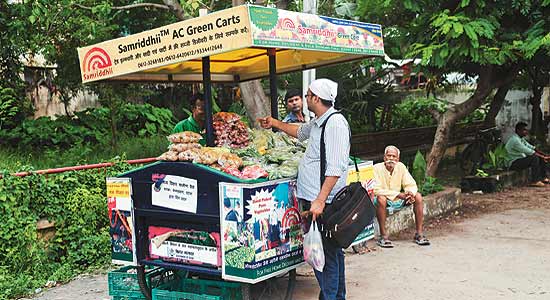In India, as most of the developing world, being a farmer is equivalent of being a looser who did not get a well paid job in town. Clearly, being a subsistence farmer, producing his/her own food in a low productive manner is not a very sexy job, nor a fulfilling career. I was told, if you are a farmer in India, you won't get a wife...
 |
| Mr Rajbardhan Sharma explaining his vision |
In many developing countries, and especially in Bihar, agriculture is at the edge of a transformation.
Young people have left the rural areas, the government has offered schemes to landless people, who usually would be cheap daily laborer, to move out to agricultural work. As a result, rural area suffer of a massive shortage of agricultural laborer. Also as people move to town, land because available for sale or for lease. It might sound dramatic, but is probably a once in a lifetime opportunity for young agri-enterpreneur to start their business and make a bet on increasing scale and mechanization. Being a farmer in this new context, is being a smart entrepreneur who understood that producing food is producing a product that will never become obsolete and that always will have a market. It is about taking the challenge of being the change that everyone is talking about and make money from it. I guess this agri-entrepreneur has nothing to do with the subsistence farmer who does not even deserve a wife...

On my trip to Nalanda, i met one of the very few young people who took up the challenge. Mr Rajbardhan Sharma left his well paid IT job in Banglore a year ago to start a dairy farm with his brother on this parents farm. He was lucky to be able to dispose of about 1.5 hectare of land (which is above the average in the area) and put all his savings into a well developed dairy farm with 2 milking machines.
He is delivering is 230 liters of milk daily through the state milk union. As milk price is fixed and relatively low, he is betting on reducing production costs, increasing in scale to benefit from return to scales and increased productivity. At this stage he is also making money from selling fertilizers produced from his manure.
Today, he still can get almost all the fodder from his fields that he cultivates in the rice-wheat system and some fodder grasses. He believes in an integrated farming system, but as he will increase in scale he will need to rely on the fodder market or get more land. He has not yet put a lot of thoughts about optimizing the cows' diet, to improve milk productivity. But i am sure this will be one of this next steps.
 |
| The free range space is in process to be build and can host up to 60 cows |
He gets the cows from another state to ensure the good quality of his breeds. As acquiring new cows are not so easy, he is also thinking of becoming a breeder's farm for the region.
We sat there in the cow shed sharing ideas about agriculture and dairy around the world (comparing to a Dutch and Kenyan system), we were going through more or less crazy ideas on how technology and institutional innovation could disrupt the current dairy system and lift more people out of poverty. More than just an interview, we had a real exchange of ideas between social entrepreneurs and I hope that social media will help us to keep doing so! Also the agricultural world has become smaller!
I left the farm with deep respect for this young man who decided to go against all odds into agriculture and proof to his family and friends that far from being a survival job, agri-entrepreneur not only can generate good money, but also contribute positively to a social change that benefits to the people of his country!













